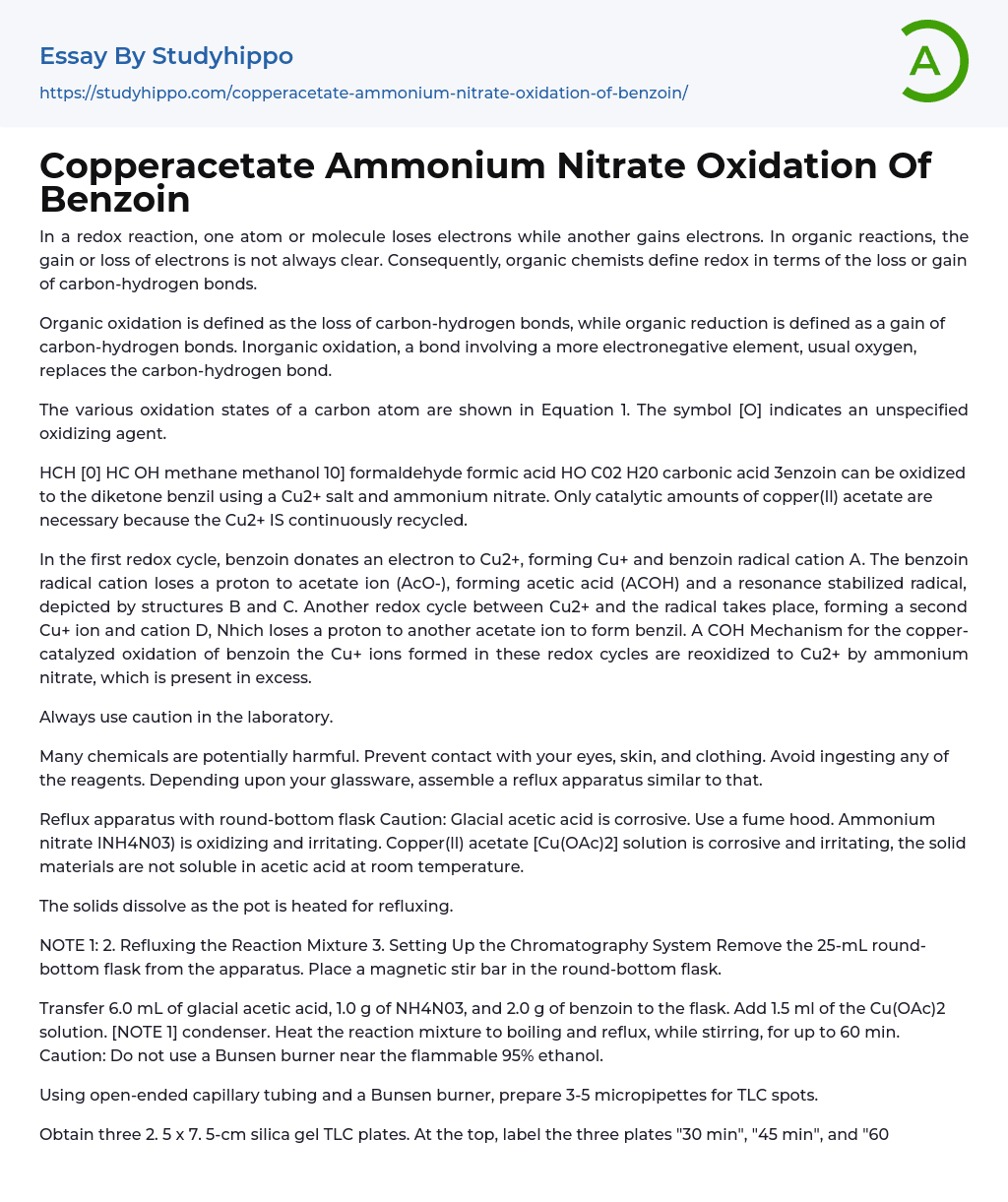

Copperacetate Ammonium Nitrate Oxidation Of Benzoin Essay Example
In a redox reaction, one atom or molecule loses electrons while another gains electrons. In organic reactions, the gain or loss of electrons is not always clear. Consequently, organic chemists define redox in terms of the loss or gain of carbon-hydrogen bonds.
Organic oxidation is defined as the loss of carbon-hydrogen bonds, while organic reduction is defined as a gain of carbon-hydrogen bonds. Inorganic oxidation, a bond involving a more electronegative element, usual oxygen, replaces the carbon-hydrogen bond.
The various oxidation states of a carbon atom are shown in Equation 1. The symbol [O] indicates an unspecified oxidizing agent.
HCH [0] HC OH methane methanol 10] formaldehyde formic acid HO C02 H20 carbonic acid 3enzoin can be oxidized to the diketone benzil using a Cu2+ salt and ammonium nitrate. Only catalytic amounts of copper(ll) acetate are n
...ecessary because the Cu2+ IS continuously recycled.
In the first redox cycle, benzoin donates an electron to Cu2+, forming Cu+ and benzoin radical cation A. The benzoin radical cation loses a proton to acetate ion (AcO-), forming acetic acid (ACOH) and a resonance stabilized radical, depicted by structures B and C. Another redox cycle between Cu2+ and the radical takes place, forming a second Cu+ ion and cation D, Nhich loses a proton to another acetate ion to form benzil. A COH Mechanism for the copper-catalyzed oxidation of benzoin the Cu+ ions formed in these redox cycles are reoxidized to Cu2+ by ammonium nitrate, which is present in excess.
Always use caution in the laboratory.
Many chemicals are potentially harmful. Prevent contact with your eyes, skin, and clothing. Avoid ingesting any of the reagents. Depending upon your glassware, assemble a reflu
apparatus similar to that.
Reflux apparatus with round-bottom flask Caution: Glacial acetic acid is corrosive. Use a fume hood. Ammonium nitrate INH4N03) is oxidizing and irritating. Copper(ll) acetate [Cu(OAc)2] solution is corrosive and irritating, the solid materials are not soluble in acetic acid at room temperature.
The solids dissolve as the pot is heated for refluxing.
NOTE 1: 2. Refluxing the Reaction Mixture 3. Setting Up the Chromatography System Remove the 25-mL round-bottom flask from the apparatus. Place a magnetic stir bar in the round-bottom flask.
Transfer 6.0 mL of glacial acetic acid, 1.0 g of NH4N03, and 2.0 g of benzoin to the flask. Add 1.5 ml of the Cu(OAc)2 solution. [NOTE 1] condenser. Heat the reaction mixture to boiling and reflux, while stirring, for up to 60 min. Caution: Do not use a Bunsen burner near the flammable 95% ethanol.
Using open-ended capillary tubing and a Bunsen burner, prepare 3-5 micropipettes for TLC spots.
Obtain three 2. 5 x 7. 5-cm silica gel TLC plates. At the top, label the three plates "30 min", "45 min", and "60 min", respectively.
Using a ruler as a straightedge, draw a very faint pencil line across each plate 1 cm from the bottom. Do not cut through the silica el with your marks. Make three small vertical lines that intersect the horizontal line at 6, 12, and 18 mm from the left side of the plate.
Using a pencil, label the plate from left to right below the vertical lines with "Bzo", 'Rxn", and "Bzl". Caution: 3enzil is irritating.
Obtain standard samples of benzoin and benzil from your laboratory instructor. Using a micropipette, spot benzoin at the position labeled Bzo on each
plate. Discard the micropipette. Using a new micropipette, spot benzil at the position marked Bzl on each plate.
Discard Dichloromethane is toxic and irritating. Prepare a developing chamber by adding 6 mL of dichloromethane to a 250-mL beaker.
Add filter paper to the chamber to act as a wick. Cover the chamber with aluminum foil or plastic wrap and set it aside in a fume hood.
Monitoring the Reaction After 30 min, remove the heat from the flask. Allow the reaction mixture to cool for 2 Nork quickly to minimize the time the reflux is interrupted. Remove the condenser from the reflux apparatus. Use a micropipette to spot the reaction mixture on the 30 min TLC plate at the position marked Rxn. Replace the condenser and restart the
- Distillation essays
- Amylase essays
- Magnesium essays
- Acid essays
- Calcium essays
- Carbohydrate essays
- Carbon essays
- Chemical Bond essays
- Chemical Reaction essays
- Chemical reactions essays
- Chromatography essays
- Concentration essays
- Copper essays
- Diffusion essays
- Ethanol essays
- Hydrogen essays
- Organic Chemistry essays
- Osmosis essays
- Periodic Table essays
- Ph essays
- Salt essays
- Sodium essays
- Titration essays
- John Locke essays
- 9/11 essays
- A Good Teacher essays
- A Healthy Diet essays
- A Modest Proposal essays
- A&P essays
- Academic Achievement essays
- Achievement essays
- Achieving goals essays
- Admission essays
- Advantages And Disadvantages Of Internet essays
- Alcoholic drinks essays
- Ammonia essays
- Analytical essays
- Ancient Olympic Games essays
- APA essays
- Arabian Peninsula essays
- Argument essays
- Argumentative essays
- Art essays
- Atlantic Ocean essays
- Auto-ethnography essays
- Autobiography essays
- Ballad essays
- Batman essays
- Binge Eating essays
- Black Power Movement essays



